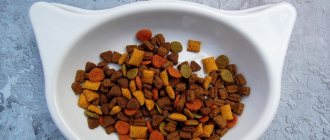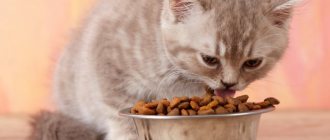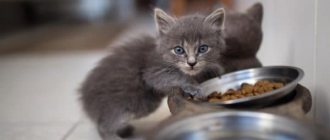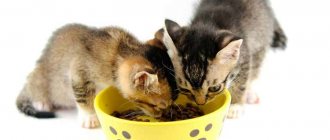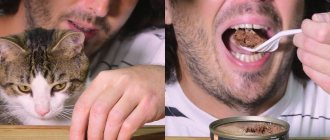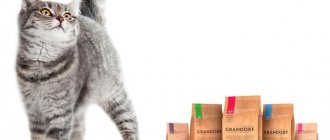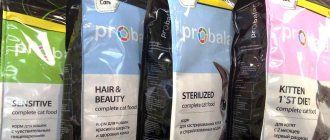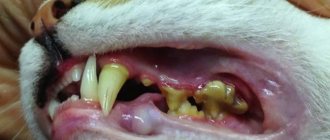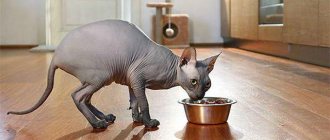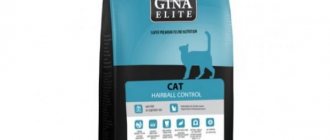Dry cat food
- Fact:
Food is given in small portions in a shallow bowl; you can lightly poke the kitten’s muzzle into the food, but not with your nose, but with your lips - Fact 2:
Food pellets are soaked in warm broth or water, but without allowing excessive swelling - Fact 3:
Since this type of food is completely balanced, you should not overfeed the kitten, but also feed what is called “by eye” - Fact 4:
The process of switching to dry food is more complicated with an adult cat than with a kitten.
Having found a new furry friend, every owner faces the question of what and how to feed little Purr? A kitten's diet can consist of either natural food or prepared food. Both options have their advantages, and increasingly, breeders prefer dry food. When choosing, the decisive factor is the lack of time to regularly prepare natural food for your pet.
But while saving time on preparation, owners are faced with another problem - the reluctance of both kittens and adult cats to eat such food. How to quickly accustom your baby and adult felines to dry food, as well as the benefits of such nutrition, is described below.
The case for ready-to-eat feeds
Contrary to popular opinion about the dangers of dry food, a number of arguments are given in defense of this diet. Veterinarians have also long ago refuted this erroneous belief, and many owners note the following benefits:
- composition - good dry food, it is a balanced amount of proteins, fats and carbohydrates necessary for the body. The required minerals, vitamins and easily digestible fiber are also included in the product;
- risks for food poisoning are almost eliminated . The possibility of poisoning cannot be completely ruled out, however, well-known manufacturers value their reputation, and high-quality feed, especially the premium class, does not include any harmful chemical components;
- dosage - on each package of ready-made food, the recommended daily intake is always written down, taking into account the weight and age of the animal, which is convenient both for calculating portions and for purchasing the required amount for a certain period of time;
- individual needs - the ability to choose according to the characteristics of the pet: age, health status, reactions to allergens, weight, etc.;
- storage – dry food does not require special conditions, opened packaging is stored for a long time without spoiling or weathering, like natural products;
- combination - dry food can be combined with wet ready-made food, and combined with a small amount of regular food, which greatly facilitates the task of accustoming the cat to new dry food.
And it is immediately necessary to make a reservation on the last point - such a combination is permissible only in the early stages of changing the diet; further feeding does not allow mixing dry food and natural food. Failure to comply with this rule can have a detrimental effect on the health of the pet and cause serious disruptions in the functioning of the body. Therefore, frequent feeding is excluded.
Why switch to a dry diet?
Dry food has a number of important advantages:
- Balanced composition. High-quality products contain the optimal amount of animal protein, fiber, minerals, vitamins and amino acids. With a natural diet, choosing the right proportions is quite difficult.
- You can choose food that is suitable for the animal’s age or condition: many manufacturers have special diets for kittens, adult and elderly pets, for allergy sufferers, etc. There are veterinary lines for sick animals. It is recommended to switch sterilized pets to diet food with a minimum of magnesium and phosphorus - this helps to avoid obesity and urolithiasis. It is even more difficult to provide your pet with such a highly specialized diet on your own.
- Save time. Menu planning, purchasing and preparing products for natural food take a lot of time.
- Unlike natural and wet food, dry food does not spoil for a long time even in the heat. If the animal is not prone to overeating, such food can be left in excess in the bowl: the cat can have lunch while the owners are at work. Dry food can be used to refill all types of automatic feeders.
- Dry food hardly stains your hands and things, so you can keep a few granules with you - this is important in cases where you have to tame a wild street kitten.
Please note that all of the above benefits apply to truly high-quality products, that is, premium, super-premium and holistic food. Economy class products are made from low-quality raw materials, contain carcinogens and other harmful substances, and therefore can cause enormous damage to the health of the animal.
Transfer to medicated feed should be carried out only after discussion with a specialist.
Dry food in a kitten's diet. How to train?
According to the advice of veterinarians, kittens should be accustomed to dry ready-made food no earlier than 3 months of age , it is by this time that babies will have formed teeth and will be able to chew new solid food.
A kitten that has been weaned from its mother and has not tried any other food other than cat’s milk should be introduced to new food gradually, and before being transferred to dry food, it should be fed for a while with either soft crushed natural food or ready-made wet food.
The food is given in small portions in a shallow bowl; you can lightly poke the kitten’s muzzle into the food, but not with your nose, but with your lips. Even if he refuses at first, in the future the kitten will still try new food, attracted by its taste and smell. The same is done with wet food.
But kittens can be accustomed to dry food after they have weaned off their mother’s milk and become accustomed to other food. To do this, you can add a little dry food to the soft food so that the kitten shows interest in the new granules. By eating them along with already familiar food, he will recognize their taste and will not reject them.
The second option, how to accustom a kitten to dry food, is not significantly different from the previous one, and is easy to use. The food granules are soaked in warm broth or water, but without allowing excessive swelling. This way the kitten will be more willing to try a new type of food. Gradually, the amount of soaked granules is reduced, and then the food is given out completely dry.
When feeding kittens with dry food, it is important to remember and follow the recommended dosages and number of feedings per day. Since this type of food is completely balanced, you should not overfeed the kitten, but also feed what is called “by eye”. It is better to read the manufacturer's recommendations indicated on the food packaging and adhere to the daily intake in accordance with the weight and age of the baby.
If a kitten refuses dry food, do not panic; sooner or later, the baby will become hungry to such an extent that the instinct of self-preservation will force him to eat the only available food that you give him. Moreover, dry food is quite aromatic and attractive to cats, and they eat it very willingly.
Which food to choose?
The correct choice of dry food determines whether the baby will get used to the new diet and how the change in menu will affect his health. Veterinarians advise buying food that is produced specifically for kittens. Moreover, it will be easier to accustom cats to a new menu with them.
Almost any brand's product line includes specialized dry food for kittens. It is important to choose a super premium or holistic food that meets the needs of the carnivorous animals that are cats.
How to accustom an adult cat to dry food
The process of switching to dry food in the case of an adult cat is more complicated than with a kitten. A pet, accustomed to receiving various treats every day, will be, to put it mildly, stunned to find unfamiliar granules in a bowl instead of meat and fish. Considering the capricious behavior of cats, you can be prepared to completely ignore the new food and express protest in ways available to cats. Some tips on how to retrain a capricious pet:
- You shouldn’t immediately and completely fill your cat’s bowl with new food; for starters, it’s enough to give a couple of crispy balls to try as a kind of treat;
- having tried several pieces of food a couple of times, the cat, of course, will not get used to it, but will not be wary and distrustful, remembering that these peas, although not familiar, are edible;
- after the first tests, you can put more food in the cat’s bowl, and if the cat still tastes and eats it, then you can pamper the furry one with a small “natural treat”;
- if the animal continues to persist and does not want to accept new food, you need to show restraint and still leave only dry food in the bowl until the completely hungry cat eats it. After which you can treat a small amount of familiar food, repeat this several times, developing a new reflex in your pet - he must remember that he won’t get the “treats” until the dry food is eaten;
- then continue according to the kitten’s nutritional plan - there should be more and more dry food per serving, and less natural feeding, and so on until it is completely eliminated.
When transferring an adult cat from a natural diet to ready-made food, the owner needs to have patience and restraint, and not follow the lead of the furry pet. Temporary hunger strikes of a protesting cat will not cause damage to his body. Therefore, you should not deviate from your goal, and do not arrange regular feeding with forbidden delicacies from now on, looking at the sad appearance of the fluffy. Small rewards are allowed at the beginning of the diet change, after which only one type of food remains, since mixed feeding will have a detrimental effect on the pet’s health.
How many times a day should kittens be fed?
The number of feedings depends on the cat's habits and age.
Little ones are given more attention, giving food 3-4 times a day. Adults are usually provided with food twice. When accustoming your baby to dry food, it is recommended to leave dishes with granules freely available so that the pet can come up and have a snack at any time.
It is important to strictly follow the dosage indicated on the package
In nature, cats eat fractionally, in small portions. This is exactly how you need to train your pet to eat. However, cats are known to be gluttons who eat everything they are given and ask for more. For such animals, dietary products and strictly dosed portions are provided; food should not be left freely available to them.
Read more about how many times a day you need to feed a cat, kitten and female cat.
How to accustom a cat to dry food in a week
It is unlikely that it will be possible to retrain a cat to a new diet in a few days, but in a week it is quite possible, but more often than not it takes more time. You should not skimp on your first dry food; it is better to purchase it of proper quality and good taste, so as not to push your pet away from unusual food.
Sequence of steps in changing nutrition:
- on the first day, a small amount of dry food balls soaked in water is placed on the plate with the same food. When it’s time to eat, the animal is unlikely to ignore them all; the cat will still try some part and learn a new taste;
- over the next two to three days, the amount of softened food increases, natural food is still not excluded. By the way, you can soak the granules not just with boiled water, but also with heated broth or milk, taking into account your pet’s taste preferences;
- on the fourth or fifth day, dry food can be added without soaking, but by mixing the granules with regular food;
- on the sixth day , there should be almost no natural products in the food bowl, the main volume is allocated to dry food;
- After a week, you can try to give a portion of 100% dry food.
When switching an animal to dry food and subsequently regularly feeding it with balanced granules, it is necessary to ensure the availability of clean drinking water for the animal. Because both a change in diet and dry food itself cause and intensify thirst. Also, monitor how your pet’s body reacts to new food; if significant problems arise in the gastrointestinal tract, contact a veterinarian. Perhaps the selected food is not suitable for your cat; after consulting with a specialist, you will select another, more suitable one.
Optimal age to change a kitten's diet
As soon as they are born, kittens find the strength to crawl to their mother’s nipple to take their first sips of colostrum. At birth, kittens' intestines are sterile, meaning they cannot process any food. Colostrum is rich in beneficial bacteria that help newborn kittens process their mother's milk.
From the moment of birth until approximately one month of age, kittens feed only on their mother's milk. As babies grow up, they begin to smell. At about one month of age, kittens begin to be attracted to the smells of adult food. As soon as the babies begin to leave the nest, the breeder introduces supplementary food into their diet.
Depending on the preferences of the breeder, the kittens begin to be supplemented with:
- Boiled minced meat, low-fat dairy products.
- Canned industrial food for kittens.
After supplementary feeding is introduced, kittens begin to grow more actively and quickly expand their diet. All this time, the baby’s digestive system adapts to digesting new food. With the correct, gradual introduction of supplementary feeding, no negative effects on the gastrointestinal tract are observed. If the gastrointestinal tract is hypersensitive, kittens may develop diarrhea.
Digestion of a kitten at 2–3 months
At 2 months, kittens begin to actively explore the world and try it out. In addition to the function of determining the edibility of an object, chewing and licking everything around has an additional function. Bacteria constantly enter the kitten’s body, and the immune system fights them.
Little kittens receive immunity from their mother, or rather, they receive antibodies from her milk. As soon as the kittens start supplementing, they begin to develop their own immunity. By the way, the mother’s immunity will protect babies up to 3 months of age.
At 3 months, kittens receive their first worm prevention and vaccination. At this stage, the already established functioning of the gastrointestinal tract may fail. Vaccination involves introducing a weakened virus into the body, followed by the development of immunity to it. After vaccinations, the kitten may experience a slight increase in base temperature and gastrointestinal upset.
Digestion of a kitten at 4 months
At 3–4 months, kittens usually move to a new home
Theoretically, the baby’s body will be ready for a change in diet, however, it is important to consider that the functioning of all body systems is greatly affected by stress. Weaning, moving to a new home and other stressful situations can affect the functioning of the gastrointestinal tract
To reduce risks, new owners are not recommended to change the kitten’s diet and feeding schedule during the adaptation period. As practice shows, three-month-old kittens fully adapt to their new housing within 7–10 days. Before buying a kitten, be sure to consult with the breeder, find out what supplementary food the kittens received and stock up on the necessary products for the next two weeks.
What to remember when switching to dry food
If you are determined to transfer your pet to a new balanced dry food, you should not forget about simple rules:
- You cannot suddenly deprive a cat of natural food by offering only dry food as a replacement. A sudden transition will not bring any positive results, but it may well be harmful to health.
- You can’t follow the cat’s lead , giving in to a plaintive meow and a sad look. You should not interrupt the transition process, and in such cases treat the cat with now forbidden natural products. Excessive feeding will prolong the process and harm the pet’s body.
- You cannot scold a cat when he refuses unusual food. The animal will receive additional stress and will not touch it at all.
Everyone remembers that a cat is an animal that walks on its own. You won’t achieve anything from her with force and rudeness, but reaching an agreement with her is quite possible. Taking into account the information presented, switching to dry food will not be a difficult task. By following the advice tested by many owners, you can accustom a kitten to dry food in a short time, without spoiling the nerves of either yourself or the animal.
Typical mistakes in introducing dry food
For some reason, many kitten owners are sure that there is no need to accustom their pet, and that the kitten itself must guess that the food offered is nothing more than its breakfast, lunch or dinner. Most likely, such owners are guided by the principle “if you want, you can eat whatever.”
However, this is a bad strategy. Firstly, it is ineffective, and secondly, a kitten with its sensitive digestion and weak immunity will easily develop serious health problems, which the owner will have to solve.
That's why:
- You should never punish a kitten for refusing dry food;
- It is prohibited to force an animal to dry food;
- You cannot speed up the process at will.
How to organize the transition to a new diet?
If your pet is accustomed to natural food, cat pates or canned food, act gradually - over 10-14 days. On the first day, replace a quarter (25%) of the daily ration with dry granules. Then increase their share every day, gradually bringing it to 100%. There is no need to worry if the baby does not eat everything at once, but spreads out the meal over several hours: for cats, it is natural to eat in small portions - often, but in small portions.
What to do if the kitten completely ignores dry food or tries to bury it like the contents of the tray? Try first filling the granules with warm water, after which they will become softer, and therefore more similar to natural food in smell and consistency. The nutritional value and digestibility of the feed will not change at all.
The only drawback is that moistened food quickly weathers and loses its attractiveness to the animal. Therefore, as soon as the kitten gets used to the taste and aroma of the new product, it is worth gradually replacing the moistened granules with dry ones.
How to start training
There are many situations in which a cat has to be switched to dry food from wet or natural food. The most difficult thing to transfer correctly is kittens: they have high water needs.
If the young animals are not separated from their parents, but have simply reached the age of 2.5-6 months, training the kitten will be easier. Identical stamps are poured onto the mother and kittens, water is poured in and left.
Flavoring additives attract attention, and the lack of other food and the cat’s appetite provoke small pets to want to try new food. By imitating their mother, they quickly and easily relearn
Is it possible to give cats canned fish?
Is Whiskas harmful for cats and kittens?
Is it possible to give a cat milk?
When a kitten is taken from its mother at an early age (up to 2-3 months), the owners will have to take full responsibility for the well-being of the cub. In the first days, it is better to feed the animal with what it was given before. Introduce new complementary foods little by little; you can add them to the previous type of food.
About the choice and quality of food
Most owners decide to switch their pet to dry food for a trivial reason - there is no time to cook for the pet separately. The reason, frankly, is valid, since high-quality dry food is many times better than food from the table. Moreover, feeding from the table is dangerous for the development of allergies, obesity, diabetes and other ailments with equally frightening names.
If you decide to switch your pet to dry food, it is important to consider in advance not only the pros, but also the disadvantages that you may encounter. Let us immediately note that dry food has more advantages:
Let us immediately note that dry food has more advantages:
- Easy to buy, easy to store and no cooking required.
- Easy to dose.
- The food is already balanced and fortified, no additives or dietary adjustments are needed.
- It has an attractive smell and is usually eaten with pleasure by cats.
There are also disadvantages:
- The food may be fake, it is not immediately obvious, but damage to health is guaranteed.
- Food purchased by weight may not be fresh, mixed with expired food, or of poor quality.
- Constantly feeding only dry food is fraught with rapid damage to teeth. At the same time, when diluting the diet with canned food, drying has a preventive effect.
- Good food costs “good”.
When deciding to switch your cat to dry food, you must understand that it comes in different qualities. Cheap, advertised economy-class food is not suitable for everyday feeding of an animal.
Products become cheaper due to:
- Replacing animal proteins with plant proteins.
- Using soy or legumes as a base.
- The use of flavor enhancers and flavorings to develop addiction in animals.
- The use of preservatives, most often salts, to extend shelf life.
- Using dyes and additives to create an attractive appearance and smell.
It’s paradoxical, but against the backdrop of such strict savings on the composition of feed, manufacturers invest huge amounts of money in its advertising. Economy class food can only be considered as a temporary measure, for example, during a move or other circumstances that do not allow you to feed your cat something else.
Premium and super-premium food is suitable for everyday feeding of healthy animals. The premium line is considered everyday and assumes ideal animal health. Only the super-premium segment is suitable for feeding sterilized cats or animals with health problems.
Holistic class is considered the highest quality; no preservatives should be used in its production... which affects the price.
What to do if the kitten doesn't eat?
Sometimes a pet, accustomed to wet food, perceives dry granules as something inedible and completely ignores them. Try stimulating his interest in new foods in different ways.
- First fill the granules with warm water until they swell. This way their aroma will become more pronounced, and the consistency will be closer to what a kitten is used to. The digestibility and nutritional value of the product will not change at all. As soon as the kitten begins to willingly eat soaked dry food, start adding several granules of dry food to it, increasing their share daily.
- Offer the animal a new product during play, while rewarding and praising it. In this way, he will develop a positive attitude towards dry food, and mistrust will gradually disappear.
- If the kitten does not eat dry food in its pure form, add some canned food to the bowl, which kids usually eat with pleasure. You should not use milk for these purposes, as it often causes digestive upset in cats. After getting used to the taste and aroma of the new food, the “taste improvers” are gradually removed.
- If you can’t get your kitten used to dry food, try using another product of similar quality. Cats are known as picky eaters: some like food based exclusively on meat ingredients, while others prefer a fishy taste. Acana Pacifica and Orijen Six Fish are good options for the latter.
Please note that when soaking food or mixing it with wet food, you cannot leave it for a long time: it quickly weathers and loses its attractiveness to the animal, and in the heat it can deteriorate and cause poisoning. It is advisable to offer the kitten a fresh portion every time or, at a minimum, put the uneaten food in the refrigerator until the next feeding.
It is enough to pour dry granules twice a day - morning and evening.
The food is spoiled
Sometimes owners think that the cat is tired of food, and they rush to the pet store to pick up something new. We hasten to assure you: the desire for variety is not typical for cats. In fact, they are quite conservative. And they have many fewer taste buds compared to humans, so gourmets are extremely rare among them.
If they like some food, they are ready to eat it all their lives, without requiring a menu update. But they sense odors very keenly, and when the food is spoiled, they immediately refuse it. It is easy to identify the problem by the following signs (one or more may be observed):
- the cat suddenly stopped eating dry food, which he had previously been willing to eat for months;
- the product’s expiration date indicated on the package after the words “Best before” or Best before (BB) has expired;
- the food was stored incorrectly: in a warm or humid place, in direct sunlight, in an open container;
- you have poured too much granules.
In the latter case, the fact is that with prolonged contact with air, the food ceases to smell intensely. It is smells that attract cats. If you add some fresh ones to the stale granules, your appetite will return.
How often should you feed a kitten?
Feeding kittens must be properly organized
It is very important that the kitten is always full, but does not overload its digestive system. Overfeeding can cause indigestion, disrupt metabolism, cause diarrhea, and systemic disruptions in the body.
By the age of two months, a kitten should eat five to six times a day. This is due to the fact that their small tummy is not able to accommodate much food. In addition, we should not forget that the gastrointestinal tract is not completely populated with beneficial microorganisms responsible for digestive processes. Therefore, kittens should be fed in small portions. Food is given at the same time.
When the kitten grows a little and reaches the age of three months, the frequency of feedings can be reduced to four times, while slightly increasing the portion of food or ready-made food.
https://youtube.com/watch?v=7DdEk63WvmA
When the kitten is six to seven months old, the frequency of feedings is gradually reduced to three times a day. At the age of 8–9 months, you can switch your pet to two meals a day.
Reasons for refusing dry food
When you notice your mustachioed pet's dissatisfaction, pay attention to specific behavior. Partial refusal to eat, not accompanied by other alarming symptoms, may be temporary.
If the volume in the bowl does not decrease, and the cat experiences severe weakness and apathy, contact your veterinarian. Poor appetite is one of the symptoms of many dangerous diseases. Do not ignore this point, citing the usual pickiness.
Problems with smell
Unlike human receptors, cats are less developed. They perceive taste less well, so when choosing food, cats are repelled by its smell. If you have problems with your sense of smell, even your favorite treats lose their attractiveness.
Poor appetite due to heat, heat, or illness
Another reason for poor appetite is hot weather. At high temperatures, not only humans, but also pets lose interest in food. If your pet lies down most of the time and drinks water heavily, just wait until it gets colder.
The problem can also occur during estrus. The period of sexual heat takes a lot of energy from the pet, so the entire body concentrates on the instinct of reproduction. Other needs are temporarily ignored. Here it is important to observe the absence of other alarming symptoms, since in this case refusal to eat can be interpreted as a sign of pathology.
In case of serious illnesses, there is not just a partial, but a complete refusal to eat. It may be accompanied by fever, gastrointestinal upset and severe weakness. If the sick animal also refuses water, make an appointment at the veterinary clinic as soon as possible. Prolonged dehydration (more than 12-24 hours) can be fatal.
Stress or regime failure
A cat may refuse food due to extreme stress. This often happens when moving, renovating, or adding a new family member.
If your mustachioed pet happily eats handouts and refuses basic food, think about the feeding regime. The lack of a strict schedule and frequent feedings are fraught with overeating and pickiness. By the time of feeding, the cat simply does not have time to get hungry or deliberately ignores the food in the hope of begging for something more tasty.
Rejection of pellets as food
If you have just recently switched your pet to dry feeding after natural feeding, just give him time. The rejection is explained by the less pronounced smell and taste characteristic of ordinary products.
If the cat has been drying for more than a year, check the condition of the teeth. If you have problems with the oral cavity, chewing on hard particles is very painful. In this case, the animal will regularly visit the kitchen and ask for food.
Unsuitable product
This problem often occurs when switching to a higher grade food. Budget brands contain dangerous flavor enhancers and flavorings, while expensive brands contain only natural ingredients.
After poor-quality feeding, the animal needs time to get used to the new diet. In this case, it will be similar to a person trying to switch to a healthy lifestyle after eating fast food for a long time.
Also, the cause of deterioration in appetite may be dissatisfaction with a too monotonous menu. In this case, the diet should be slightly adjusted by adding wet canned food or replacing the existing “crackers” with a different brand.
Damaged product
The taste of ready-made cat food can be ruined not only by the expired expiration date, but also by improper storage. Once the package is opened, the contents quickly oxidize, becoming rancid. Such a product can cause poisoning, so the animal will instinctively refuse it.
Dirty bowl or feeding area
Whiskered pets are very clean. They will not eat from a dirty bowl or eat near their toilet.
In addition to dirt and location, you should consider the material used. Cheap plastic quickly absorbs foreign odors, so the contents of the bowl become unpleasant for the animal. Also, water from a nearby bowl can get into the crackers, turning them into a soggy mess.
Age of a kitten for the first acquaintance with dry food
You should always start with a minimum amount of soaked dry granules. Depending on the behavior and interest in dry granules, adjust the process taking into account the individual characteristics of the pet. If you start to force things, there is a risk of scaring the kitten, after which the transition will be much longer.
When living together with a mother cat, the growing baby will definitely begin to imitate her. When eating, he will stick his face into the bowl of kibble while the cat is eating. And gradually it will begin to capture pieces, thus becoming acquainted with the new taste. Therefore, the owner’s participation may not be necessary.
